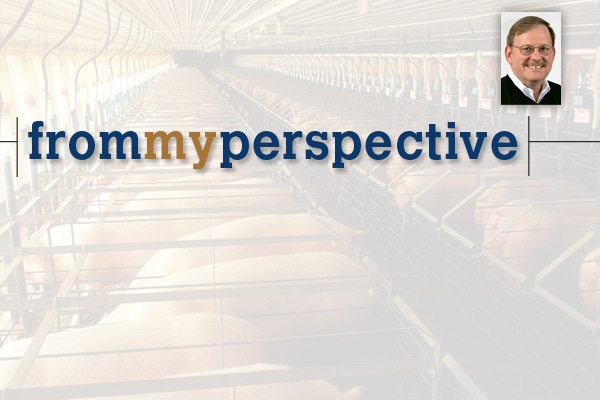Why is it that whenever you mix unfamiliar sows or pigs in a group a fierce battle ensues? It’s in their genes. Pigs are hard-wired to establish a hierarchy when placed in the near proximity of others. That’s the conclusion USDA livestock behavioral specialist Jeremy Marchant-Forde offered at a sow housing workshop during the Leman Swine Conference recently. But he adds a caveat: Given a choice, they might just avoid the altercation altogether. At least, that’s what their ancestors would do.
November 15, 2012

Why is it that whenever you mix unfamiliar sows or pigs in a group a fierce battle ensues?
It’s in their genes. Pigs are hard-wired to establish a hierarchy when placed in the near proximity of others. That’s the conclusion USDA livestock behavioral specialist Jeremy Marchant-Forde offered at a sow housing workshop during the Leman Swine Conference recently. But he adds a caveat: Given a choice, they might just avoid the altercation altogether. At least, that’s what their ancestors would do.
In the wild, social groups of sus scrofa (Old World wild pigs) were generally quite small, related and comprised of females and their offspring. Their predecessors, still roaming parts of the country, confirm this activity.
These ancestors to modern-day sows would leave the group to have their litters, then return to slowly introduce their offspring to the group. Groups gathered around resources. Dominant sows displaced subordinate sows, not so much with physically aggressive behavior, but by simply avoiding each other.
The groups’ home ranges would often overlap, but they kept their distance in a live-and-let-live manner. Boars were generally shunned, except during breeding periods.
“In their natural environment, they have a stable social structure of related animals with a wide profile of ages and sizes, living in unlimited space and in a complex environment, so they have a complex repertoire of activities,” Marchant-Forde explains. “They spend a lot of time actively foraging during the daytime. Domestic pigs will behave quite like their ancestors, given the opportunity.”
Of course, the demand on modern-day agriculture and the ever-increasing number of mouths to feed around the globe will not allow the luxury of unlimited space and free-range pig production.
Understanding Sow Aggression
In his talk, “The Ethology of Sow Aggression,” Marchant-Forde explains why sows act as they do when grouped together.
“Aggression occurs around the time of group formation, at mixing and then at feeding time. Invariably, when you mix pigs you get aggression that leads to the formation of a social hierarchy,” he says. “You’re never going to be able to mix pigs and not have high levels of aggression very soon after you mix them. But if the management of the system is good, hopefully the aggression dissipates and reaches a very steady, very low baseline level.”
Marchant-Forde has studied how pigs send out and read social cues and their reactions to them. He has broken down these actions and reactions into very minute measures. “It is very difficult because the cause-and-effect and their reciprocal behaviors are very different from pig to pig,” he notes.
He has studied 47 different scenarios of mixing, group size, space, etc. In those scenarios, 45 resulted in aggressive interactions, not to mention the behaviors that occurred before the aggression escalated.
“There is a lot of cagey interaction and testing that goes on before the real fight breaks out and ramps up. When space is unlimited, the strategy is quick avoidance. But when space is limited, avoidance is difficult, so the same behavior can have different results. All pigs do not have to fight each other to establish hierarchy,” he says.
Besides the obvious efforts to provide sows with a better, more consistent environment, sow housing especially has evolved to avoid these unavoidable clashes by putting them in stalls.
Group Housing Insights
In his concluding remarks, Marchant-Forde acknowledges there are many types of group housing and it is difficult to differentiate how sows respond to the various components:
• Space — There is little evidence of an optimum space allowance. In groups, limited space results in more aggression, more bites.
• Depending on the feeding and housing system you have, sows are competing for access to a potentially scarce resource — feed. That is when the social hierarchy is reinforced, more so in groups, but also in stalls.
• Pre-exposure — When sows have nose-to-nose contact, getting to know each other through gate bars, aggression decreases.
• Stall stress — Marchant-Forde observes there is some, but less, aggression between sows in gestation stalls vs. groups. “There may be some frustration by sows in stalls because a hierarchy cannot be successfully established,” he notes.
• Genetic lines should be studied to see if some do better in groups.
• Adaptability — Does the experience of the animals within a system allow them to adapt? He’s not sure, “but much of the aggression seems to subside by the fourth parity.”
Of one thing he is sure: “Husbandry is the key. It is less about design and more about people. Invest in your people,” he stresses.
You May Also Like



